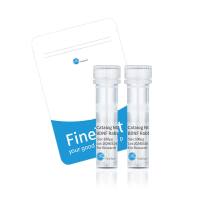Many studies of oligonucleotide binding and catalysis involve small nucleic acid targets with secondary and tertiary structures of little complexity. However, the therapeutic target of antisense oligonucleotides and hammerhead ribozymes, large RNAs, are rich in structures, such as hairpins and pseudoknots, which may make certain target sequences inaccessible to the ribozyme (1 –3 ). The methods described here are used in our laboratories to probe the accessibility of in vitro transcribed RNAs to antisense oligonucleotides and hammerhead ribozymes. The method involves first probing the end-labeled RNA with a degenerate oligodeoxynucleotide library. Treatment with ribonuclease H (RNase H) cleaves the RNA at sites of oligodeoxynucleotide hybridization, and these sites are identified by gel electrophoresis and autoradiography. Specific antisense oligodeoxynucleotides, complementary to those regions identified by the random library, can then be made to hammerhead ribozyme NUX consensus target sites, where N = A, C, G, or U and X = A, C, and U (4 ,5 ). Cleavage with RNase H can be used to evaluate the binding of these antisense oligodeoxynucleotides and so to choose target sites for ribozymes. We have used this protocol to discover several hammerhead ribozymes with excellent activity against viral RNAs transcribed in vitro.






